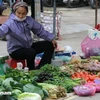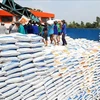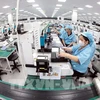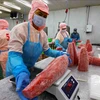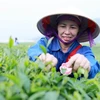Vietnam's animal husbandry industry is expected to face serious challenges under new and future Free Trade Agreements (FTAs) because of low productivity, high production costs and small scale of production.
Speaking at a conference held in HCM City on June 22, Doan Xuan Truc, Deputy Chairman cum General Secretary of the Animal Husbandry Association of Vietnam, said that FTAs would adversely affect the industry more than any other agricultural industry.
But he noted that FTAs would also help the industry access new technology, products, and animal breeds as well as production methods.
Ho Xuan Hung, Chairman of the General Association of Agriculture and Rural Development, said that lower import tariffs under new FTAs would lead to fierce competition with foreign producers.
The domestic industry is plagued with small-scale breeding, poor animal breed quality, poor breeding technology, low labour productivity, regular threats of disease and poor linkages in the production chain.
Phuc said that high bank loan interest rates had increased breeding costs, reducing the sector's competitiveness.
Production costs have also gone up because of dependence on imports for raw materials used to produce animal feed and vaccines.
In addition, technologies for processing and preservation are not advanced, limiting management of food quality.
Phuc said the domestic animal husbandry sector had been able to meet demand for 100 percent of pork meat, 95 percent of poultry meat and 75-80 percent for beef.
"If the sector does not lower production costs, cheaper imported meat will enter the market," he said.
Le Ba Lich, Chairman of the Vietnam Animal Feed Association, said to compete with imported meat, locally made meat must be competitive in price, quality, and hygiene and food safety.
He said the sector should develop a closed production chain to reduce costs and improve quality. In addition, the Government should offer support to enterprises that want to invest in concentrated breeding areas and modern slaughterhouses.
Training of human resources should also be promoted, as well as investment in environmental treatment and modern processing and preservation facilities.
Nguyen Xuan Duong, Deputy Head of the Animal Husbandry Department, said in 2013 pork accounted for 74.2 percent of total meat output, poultry 17.3 percent, cattle 8.5 percent.
The country targets raising the ratio of poultry and cattle meat to 28 percent and 10 percent, respectively, while reducing the ratio of pork meat to 62 percent, Duong said.
The conference was organised by the General Association of Agriculture and Rural Development and the Animal Husbandry Association of Vietnam.-VNA
Speaking at a conference held in HCM City on June 22, Doan Xuan Truc, Deputy Chairman cum General Secretary of the Animal Husbandry Association of Vietnam, said that FTAs would adversely affect the industry more than any other agricultural industry.
But he noted that FTAs would also help the industry access new technology, products, and animal breeds as well as production methods.
Ho Xuan Hung, Chairman of the General Association of Agriculture and Rural Development, said that lower import tariffs under new FTAs would lead to fierce competition with foreign producers.
The domestic industry is plagued with small-scale breeding, poor animal breed quality, poor breeding technology, low labour productivity, regular threats of disease and poor linkages in the production chain.
Phuc said that high bank loan interest rates had increased breeding costs, reducing the sector's competitiveness.
Production costs have also gone up because of dependence on imports for raw materials used to produce animal feed and vaccines.
In addition, technologies for processing and preservation are not advanced, limiting management of food quality.
Phuc said the domestic animal husbandry sector had been able to meet demand for 100 percent of pork meat, 95 percent of poultry meat and 75-80 percent for beef.
"If the sector does not lower production costs, cheaper imported meat will enter the market," he said.
Le Ba Lich, Chairman of the Vietnam Animal Feed Association, said to compete with imported meat, locally made meat must be competitive in price, quality, and hygiene and food safety.
He said the sector should develop a closed production chain to reduce costs and improve quality. In addition, the Government should offer support to enterprises that want to invest in concentrated breeding areas and modern slaughterhouses.
Training of human resources should also be promoted, as well as investment in environmental treatment and modern processing and preservation facilities.
Nguyen Xuan Duong, Deputy Head of the Animal Husbandry Department, said in 2013 pork accounted for 74.2 percent of total meat output, poultry 17.3 percent, cattle 8.5 percent.
The country targets raising the ratio of poultry and cattle meat to 28 percent and 10 percent, respectively, while reducing the ratio of pork meat to 62 percent, Duong said.
The conference was organised by the General Association of Agriculture and Rural Development and the Animal Husbandry Association of Vietnam.-VNA




